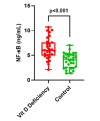Could serum Vitamin-D be an indicator of the onset of membrane rupture?
- PMID: 39926677
- PMCID: PMC11803808
- DOI: 10.12669/pjms.41.2.8930
Could serum Vitamin-D be an indicator of the onset of membrane rupture?
Abstract
Objective: Although Vitamin-D (VD) deficiency in pregnancy continues to be an important public health problem, the effects of VD on fetal outcomes are not clear. VD can show its effects at the feto-maternal junction via nuclear factor-kB (NF-kB). This study was planned to determine the effect of changes in serum VD levels on amniotic fluid NF-kB levels.
Methods: Participants were selected among patients who applied to Samsun Medikalpark Hospital Gynecology and Obstetrics outpatient clinic between November 1, 2022 and November 1, 2023. Sixty patients whose serum VD measurements were performed at 24 weeks of gestation were included in the study. The pregnant women were divided into two equal groups according to their serum VD levels (n=30). The patients in Group-1 consisted of 30 patients with a VD level less than 20 ng/ml (VD deficienct group) and Group-2 consisted of 30 patients with a VD level higher than 20 ng/ml (VD sufficienct group). NF-kB levels were measured by ELISA in amniotic fluid samples taken during cesarean section from patients in both groups.
Results: The amniotic fluid NF-kB concentration of the VD sufficient group was found to be significantly lower than the VD deficient group. The amniotic fluid NF-kB levels of the VD deficient group were approximately two times higher than the VD sufficient group (6.36±2.12 ng/mL vs. 3.95±1.49 ng/mL, p< 0.01). After adjusting for gestational age, fetal birth weight, and parity, significant associations were found between VD and amniotic fluid NF-kB. The mean gestational ages at the time of cesarean section were similar in both groups.
Conclusion: Although VD insufficiency causes early inflammatory changes in fetal membranes by increasing amniotic fluid NF-kB levels, it does not lead to preterm delivery.
Keywords: Amniotic fluid-NF-κB; Inflammation; Labor; Serum Vitamin-D.
Copyright: © Pakistan Journal of Medical Sciences.
Conflict of interest statement
Conflicts of interest None.
Figures
References
-
- Holick MF. Vitamin-D deficiency. NEJM. 2007;357:266–281. doi:10.1056/nejmra070553. - PubMed
-
- Leffelaar ER, Vrijkotte TG, van Eijsden M. Maternal early pregnancy Vitamin-D status in relation to fetal and neonatal growth:results of the multi-ethnic Amsterdam Born Children and their Development cohort. Br J Nutr. 2010;104:108–117. doi:10.1017/s000711451000022x. - PubMed
-
- Wagner CL, Greer FR. Prevention of rickets and Vitamin-D deficiency in infants, children, and adolescents. J Pediatr. 2008;122:1142–1152. doi:10.1542/peds.2008-1862. - PubMed
LinkOut - more resources
Full Text Sources


